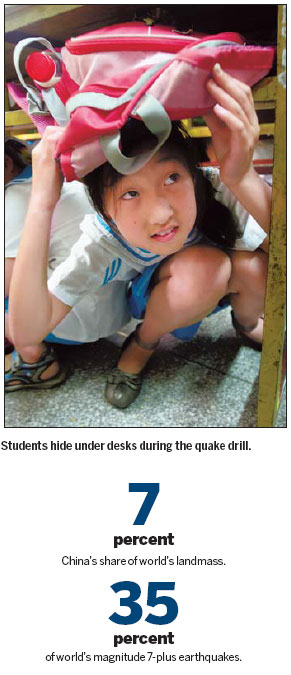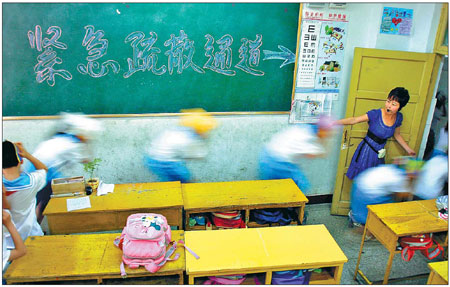Society
On one's guard
Updated: 2011-04-27 08:00
By Yang Jianxiang (China Daily)
|
Students at a primary school in Huaibei, Anhui province, evacuate the classroom during a quake drill. Photos by Li Bo / for China Daily |
 |
The recent earthquakes in Southwest China and Japan have given preparedness a new urgency in schools across the nation. Yang Jianxiang of China Features reports.
It's about 10 at night. Liu Hefan, a 3rd grader in Beijing, is already in bed. All of a sudden, she cries out, "Grandma, have you put the two boxes near the bathroom door?" "Yes,"comes the reply. But the girl is not assured. She climbs out of her warm quilt to check, while urging her grandma and mom to remain in bed. The city's centralized heating service has just been stopped. It is cold in the room.
One of the two cardboard boxes the girl gets up to inspect is filled with bags of dry foods including biscuits and fruits; the other has milk packets and bottles of water.
Hefan has been watching the TV news on the recent earthquakes in Southwest China and Japan. The two boxes are her way of preparing for a similar occurrence at home.
From her parents the girl has learnt that the Japanese were well prepared for an earthquake. This helped save a number of lives.
She says her father Liu Hejian told her "the small bathroom at home is the best place to take temporary refuge when a quake occurs. If trapped in the collapsed building, it is vital to have food and drinks, as well as a flashlight, siren, and radio, while waiting for rescue".
Liu Hejian is more concerned about the school, where his daughter stays the whole day. Although it has a large open playground, the students know little about evacuation procedures in the event of a quake.
The Legal Evening Paper (LEP), a Beijing-based daily, recently conducted a survey of 50 primary schools in four urban districts of the capital through face-to-face interviews and phone calls. More than half, or 28 schools, had never held any earthquake drills. Among them, 57 percent said they had no idea of even how to hold one.
The remaining schools said they wanted to but either did not know how to go about it, or the school administration system did not allow such an operation.
Beijing, like other Chinese cities, lacks an authoritative guidebook on earthquake response. A teacher with Guanyuan Primary School in Xicheng district says although his school has long wanted to hold an earthquake drill, efforts have been frustrated by the lack of agreement on specific approaches. Some books advise students to hide under desks when the jolting happens, while others say lying besides the desks, in so-called triangular spaces, is safer.
The same survey found that in the past three years 40 percent of the schools interviewed had organized at least one quake drill. Teachers with these schools said they designed the operations largely on their own, based on books, videos and lectures.
Zhang Long, chief of School Logistics Section, Beijing Municipal Education Commission (BMEC), says while there are textbooks dealing with ways to remain safe during disasters for primary, junior high, as well as senior high school students, "Earthquakes are normally dealt with in one chapter".
He admits there is no book dedicated solely to earthquakes.
The important thing is to train teachers and school administrators, Zhang says. A drill should be well devised to show how to respond to dangers in general as well as to specific ones. And the drill should be taken seriously, so that it really prepares participants for any emergency.
Yu Weiyue, chief of School Management Division, Basic Education Department of China's Ministry of Education, says information about earthquakes and disaster response are included in a variety of school books. There are also CDs and websites on this.
"Earthquake education is an integral part of safety education at school," Yu says, "We are well prepared."
Primary and middle schools in China are supposed to devote at least three lessons a year to safety education, on or around the last Monday of March, May 12 and Nov 9.
Statistics released by China Earthquake Administration (CEA) show that on May 12, 2010, the authorities at various levels launched a nationwide campaign on earthquake preparedness. Included in the information provided to the public was this: "China's land area accounts for 7 percent of the world total. But it accounts for 35 percent of the world's magnitude 7-and-plus earthquakes. The average rate is two 7-plus quakes every three years."
The Beijing area is not known for powerful earthquakes. But some of the nation's most devastating quakes have happened not far from the city.
In the past half-year Beijing has seen little precipitation, barring three snowfalls that were largely the result of human intervention. According to veteran Chinese seismologist Geng Qingguo, there is a high correlation between a prolonged drought and a big earthquake.
Because Geng retired from the CEA, his views do not align with those of mainstream researchers there. A major point of difference is that he believes it is possible to predict earthquakes. Geng claims to have done so on a number of occasions.
The dominant CEA opinion is that such forecasting is impossible for the short term, given the current level of seismological science. But they do agree that medium- or long-term forecasts can be made with considerable accuracy.
In light of the heavy casualties caused by previous earthquakes in its hinterland, in 2009 China launched a three-year project to check and strengthen buildings at primary and high schools across the country, during the summer and winter vacations.
Beijing is doing the same, despite the fact that its school buildings are relatively solid and the area is relatively safe.
On March 15, three days after the magnitude 9 earthquake and tsunami hit Japan, primary and high schools in Rongcheng county, Baoding, Hebei province, reportedly staged a quake drill coordinated by the county's education authority.
That morning in Baita Primary School, as soon as the siren sounded, classes were stopped, and students were urged to lower their bodies and hide under or beside their desks. Those close to the walls took refuge near wall corners, putting their hands or school bags above their heads. After about 40 seconds, they were told the quake had stopped and the evacuation began. Students hunched their backs, with hands still above their heads, and ran swiftly out of the classrooms in orderly lines and down the staircases to the playground. When all 328 students were standing in morning exercise formation in the open space, the stop-watch showed the whole exercise had taken one minute and 53 seconds.
Hebei province includes Tangshan, where a magnitude 7.8 quake in 1976 leveled the whole city, claiming more than 242,000 lives.
Hefan has since returned to her usual routines, sleeping early on the first four weekdays and staying up a little later on Fridays. She has forgotten about the boxes. But her father believes the girl is psychologically prepared for anything.
"It's better than nothing," Liu Hejian says.
E-paper

War of the roses
European Chinese rose growers are beating their Chinese rivals at their own game
High-tech park gets big boost
At the source
Merchant of Venice
Specials

Sino-US Dialogue
China and the US hold the third round of the Strategic and Economic Dialogue on May 9-10 in Washington.

Drunk driving
Drunk drivers face a detention for one to six months and a revokation of their drivers' license.

V-Day parade
A military parade marking the 66th anniversary of the Soviet victory over Nazi.

